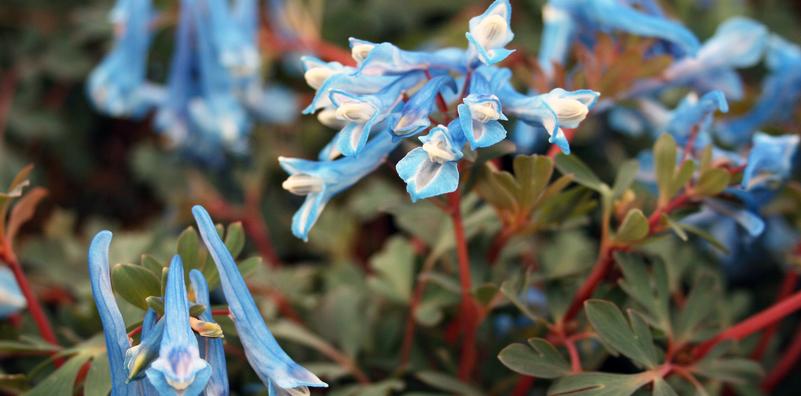Bloomin' Blues to Buzz About!
Usually, various hues of green represent the true arrival of spring – from the budding of deciduous trees, shrubs, and vines, to the emergent basal foliage of many perennials, the livening of semi-evergreen grasses, and the fresh flush of new growth on broadleaf evergreens. Mingled amongst the emerald, chartreuse, Kelly, forest and hunter greens, rare jewel tones of sapphire, indigo, cobalt, lapis and azure bring an unexpected curiosity to the garden. Typically, it is our native Mertensia virginica, Virginia bluebells, and even blue-flowering Aquilegia canadensis selections that come to mind for this specific and rather scrupulous palette.
Some perennials, like Phlox divaricata ‘Blue Moon’, are those familiar favorites that you’re likely familiar with. The blanket of semi-evergreen foliage erupts with fragrant blue-violet flowers, softening the woodland edge or part shade native garden and attracting early spring pollinators. Specifically of the insect variety. So, why exactly is that? And more specifically, why is it primarily within the perennial world that blue flowers exist?
The answer truly lies in the production of anthocyanins by angiosperms (flowering plants). Research has identified the particular anthocyanin responsible for the rare organic color, calling it delphinidin – pretty fitting when you think of the natural production of blue hues in native perennial Delphinium exataltum. However, it’s a bit more complex than that: it is most probably the combination of delphinidin with various flavonoids, and metal complex pigments, that help to push floral colors from the more-likely potentials of purple and mauve to hues of blue. Despite the rarity of blue in the wild, the noticeable increase in blue-flowering plants in biodiverse habitats suggests that plants produce more anthocyanins and recessive color traits to attract pollinators, thus ensuring more success in competition with surrounding yellow, pink, and purple flowering species. Only certain plant families are capable of delphinidin production, excluding those in Rosaceae as well as Caryophyllaceae (carnation and dianthus family), and select members of Asteraceae, specifically chrysanthemums (you might recall that blue wood asters, Symphyotrichum cordifolium are arguably blue – meaning that this family is not entirely incapable of producing delphinidin). Other plant families, like the borage family, Boraginaceae, are not only known for their blue flower production, but include perhaps some of the most popular and recognized of the kind. Quite possibly one of the best-known blue flowers of all time, the forget-me-not, has a distant perennial cousin with similarly enchanting, tiny flowers that appear in early spring – Brunnera macrophylla. Large, heart-shaped foliage marbled with silver overlaying dusty green as seen in cultivars ‘Jack Frost’ and ‘Silver Heart’ bump the floral contrast to eleven, with the azure blue flowers, small as they are, inviting closer inspection. Similarly, the flowers of various Plantaginaceae plants have been known to produce blue-dominant anthocyanins, with many leaning towards purple. The small but profuse flowers found in the Veronica genus are like the four-petaled version of forget-me-nots on steroids. Veronica umbrosa ‘Georgia Blue’ makes not only a dense, carpet-like groundcover, but becomes absolutely engulfed in bright blue flowers throughout the spring and much of the summer. Like the hard contrast of the silvery variegated foliage of ‘Jack Frost’ and ‘Silver Heart’ Siberian bugloss, the reddish-bronze foliage of ‘Georgia Blue’ speedwell creates a visual distinction in which the tiny, cornflower blue flowers become the star of the show.
If subtlety is more your speed, the icy blue-bordering-on-white flowers of Pulmonaria ‘Moonshine’ overtop of their spotty, silver and green foliage provide a hint of unexpected color in the early spring to the shade garden. Interplant with dutiful groundcover Ajuga tenorei ‘Cordial Canary’ of the Feathered Friends™ series, with its dusty blue flower buds opening to reveal cobalt blue, lipped flowers and its unique, bright chartreuse foliage. Or, maybe you’re up for something entirely different.
Corydalis curviflora subsp. rosthornii ‘Blue Heron’ is literally blowing us away with its floral display right now. Even from a distance through the doorway of its production house, it glows like a light in the darkness. Its peculiar, electric blue tubular flowers stand out against red stems and feathery, frond-like grey-green foliage, bringing a surprising and rarely seen burst of color to the part shade garden. Its demure form makes ‘Blue Heron’ fumewort a lovely underplanting companion to small or medium flowering shrubs, with the showy blue flowers blooming consistently throughout the spring and much of the summer. We only recommend planting this stunner as long as you don’t mind answering constant questions of curious audiences – it’s sure to become the focus of garden conversations when in bloom!
Make sure to get your hands on this week’s selections before they’re gone! Our inventory is going quick, so get on over to our Advanced Search on our website, filter your color options by ‘blue’, and sort by currently available inventory (a brand-new feature!) to start adding blue bloomin’ beauties to your spring projects!
See all our Perennials
Corydalis 'Blue Heron'

